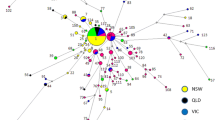Abstract
Twenty four Ascochyta rabiei isolates, collected from the 2009 eastern Australian chickpea growing regions, were assessed for their ability to infect 12 previously characterised chickpea genotypes. Comparison of means analysis and principal components analysis of area under the disease progress curve measures resulted in continua rather than discrete isolate groupings, suggesting that a broad diversity of pathogenicity exists in the current A. rabiei population. Breeders can now choose isolates that represent the variation found in the field to screen their germplasm, providing greater knowledge on the likely longevity of cultivars before they are commercially released.

Similar content being viewed by others
References
Carter JM (1999) Chickpea growers guide: a guide for the production of chickpeas. Agriculture Victoria, Department of Natural Resources and Environment
Caten C (1987) The concept of race in plant pathology. In: Wolfe M, Caten C (eds) Populations of Plant Pathogens: their dynamics genetics. 24 Blackwell Scientific Publications, Oxford, pp 21–37
Chen W, Coyne CJ, Peever TL, Muehlbauer FJ (2004) Characterisation of chickpea differentials for pathogenicity assay of ascochyta blight and identification of chickpea accessions resistant to Didymella rabiei. Plant Pathol 53:759–769
Chen W, McPhee KE, Muehlbauer FJ (2005) Use of a mini-dome bioassay and grafting to study resistance of chickpea to Ascochyta blight. J Phytopathol 153:579–587
Chongo G, Gossen BD, Buchwaldt L, Adhikari T, Rimmer SR (2004) Genetic diversity of Ascochyta rabiei in Canada. Plant Dis 88:4–10
Cother EJ (1977) Identification and control of root-rot fungi in Cicer arietinurn (chickpea). Plant Dis Rep 61:736–740
Flandez-Galvez H, Ford R, Ades PK, Pang ECK, Taylor PWJ (2003) QTL analysis for ascochyta blight resistance in an intraspecific population of chickpea (Cicer arietinum L.). Theor Appl Genet 107:1257–1265
Gowen SR, Orton M, Thurley B, White A (1989) Variation in pathogenicity of Ascochyta rabiei on chickpeas. Trop Pest Manag 35:180–186
Jamil FF, Sarwar N, Sarwar M (2000) Genetic and pathogenic diversity within Ascochyta rabiei (Pass.) Laboratory populations in Pakistan causing blight of chickpea (Cicer arietinum L). Physiol Mol Plant Pathol 57:243–254
Kaiser WJ, Muehlbaur FJ (1988) An outblight of chickpea in the outbreak of Ascochyta blight of chickpea in the Pacific Northwest, USA, in 1987. International Chickpea Newsletter 18:16–17
Leo AE, Ford R, Linde CC, Shah RM, Oliver R, Taylor PWJ, Lichtenzveig J (2011) Characterization of fifteen newly developed microsatellite loci for the chickpea fungal pathogen Ascochyta rabiei. Molecular Ecology Resources, In press
Nasir M, Bretag TW, Kaiser WJ, Meredith KA, Brouwer JB (2000) Screening chickpea germplasm for ascochyta blight resistance. Australas Plant Pathol 29:102–107
Navas-Cortés JA, Pérez-Artés E, Jiménez-Diaz RM, Llobell A, Bainbridge BW, Heale JB (1998) Mating type, pathotype, and RAPDs analysis in Didymella rabiei, the agent of Ascochyta blight of chickpea. Phytoparasitica 26:199–212
Nene YL, Reddy MV (1987) Chickpea diseases and their control. In: Saxena MC, Singh KB (eds) The Chickpea. CAB International, Oxon, pp 233–270
Pande S, Siddique KHM, Kishore GK, Bayaa B, Gaur PM, Gowda CLL, Bretag TW, Crouch JH (2005) Ascochyta blight of chickpea (Cicer arietinum L.): a review of biology, pathogenicity, and disease management. Aust J Agric Res 56:317–332
Parlevliet JE (1979) Components of resistance that reduce the rate of epidemic development. Annu Rev Phytopathol 17:203–222
Phan HTT, Ford R, Taylor PWJ (2003a) Population structure of Ascochyta rabiei in Australia based on STMS fingerprints. Fungal Divers 13:111–129
Phan HTT, Ford R, Taylor PWJ (2003b) Mapping the mating type locus of Ascochyta rabiei, the causal agent of ascochyta blight of chickpea. Mol Plant Pathol 4:373–381
Pradhan P (2006) Studies of Ascochyta rabiei in Australia. M Agr Sci thesis, University of Melbourne
Pulse Australia (2008) Genesis 425. Pulse variety management package. http://www.pulseaus.com.au/pdf/Genesis%20425%20VMP.pdf
Pulse Australia (2009a) Almaz. Pulse variety management package. http://www.pulseaus.com.au/pdf/Almaz%20VMP.pdf
Pulse Australia (2009b) Flipper. Pulse variety management package. http://www.pulseaus.com.au/pdf/Flipper%20VMP.pdf
Pulse Australia (2009c) Genesis 090. Pulse variety management package. http://www.pulseaus.com.au/pdf/GENESIS%20090%20VMP.pdf
Pulse Australia (2009d) Genesis 114. Pulse variety management package. http://www.pulseaus.com.au/pdf/GENESIS%20114%20VMP.pdf
Pulse Australia (2009e) Genesis 509. Pulse variety management package. http://www.pulseaus.com.au/pdf/GENESIS%20509%20VMP.pdf
Pulse Australia (2009f) Yorker. Pulse variety management package. http://www.pulseaus.com.au/pdf/Yorker%20VMP.pdf
Pulse Breeding Australia (2009) PBA HatTrick. Variety management package. http://www.pulseaus.com.au/pdf/Genesis%20425%20VMP.pdf
Quarantine WA (2009) Western Australia’s seed import requirements. Department of Agriculture and Food, Government of Western Australia. http://www.agric.wa.gov.au/objtwr/imported_assets/content/pw/q/seed_manual.pdf
Singh KB, Hawtin GC, Nene YL, Reddy MV (1981) Resistance in chickpea to ascochyta blight. Plant Dis 65:586–587
Taylor PWJ, Ford R (2007) Diagnostics, genetic diversity and pathogenic variation of ascochyta blight of cool season food and feed legumes. Eur J Plant Pathol 119:127–133
Udupa SM, Weigand F, Saxena MC, Kahl G (1998) Genotyping with RAPD and microsatellite markers resolves pathotype diversity in the ascochyta blight of chickpea. Theor Appl Genet 97:299–307
Vail S, Banniza S (2008) Structure and pathogenic variability in Ascochyta rabiei populations on chickpea in the Canadian prairies. Plant Pathol 57:665–673
Vail S, Banniza S (2009) Molecular variability and mating-type frequency of Ascochyta rabiei of chickpea from Saskatchewan, Canada. Australas Plant Pathol 38:392–398
Vir S, Grewal JS (1974) Physiologic specialization in Ascochyta rabiei, the causal organism of gram blight. Indian Phytopathology 27:355–360
Acknowledgements
The authors acknowledge the Australian chickpea breeders and pathologists for their advice on host genotypes, Kevin Moore for supplying the Tamworth isolates, and Kristy Hobson and Jenny Davidson for assistance with the collection of isolates in Victoria and South Australia.
Author information
Authors and Affiliations
Corresponding author
Rights and permissions
About this article
Cite this article
Elliott, V.L., Taylor, P.W.J. & Ford, R. Pathogenic variation within the 2009 Australian Ascochyta rabiei population and implications for future disease management strategy. Australasian Plant Pathol. 40, 568–574 (2011). https://doi.org/10.1007/s13313-011-0087-1
Received:
Accepted:
Published:
Issue Date:
DOI: https://doi.org/10.1007/s13313-011-0087-1




